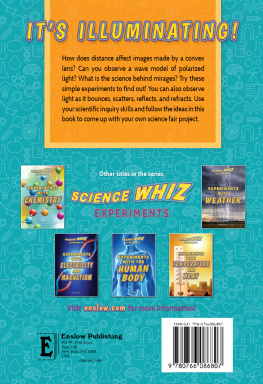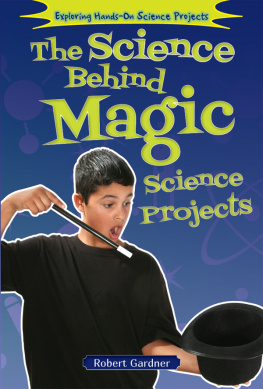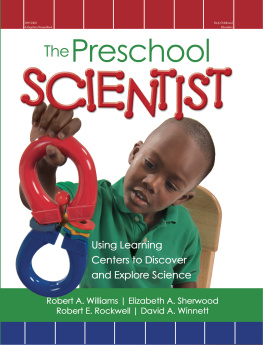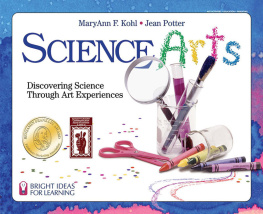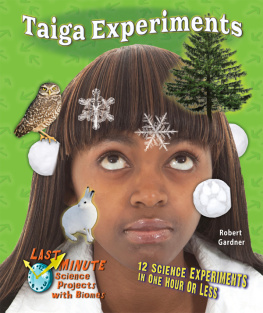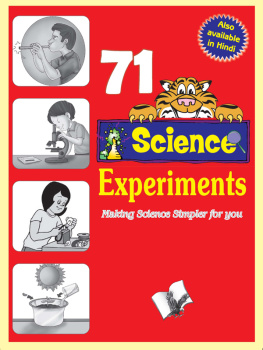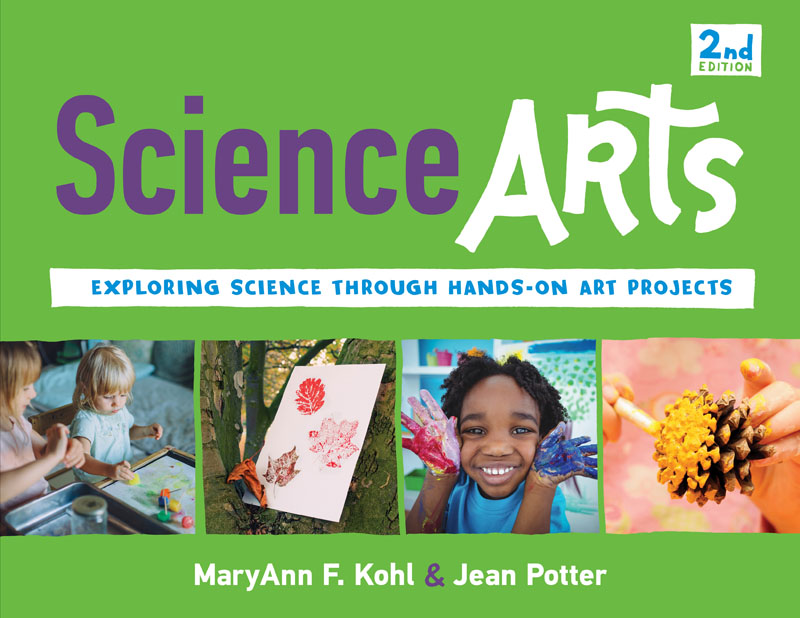
Copyright 1993 by MaryAnn F. Kohl and Jean Potter
First edition published 1993
Second edition published 2020
All rights reserved
Published by Chicago Review Press Incorporated
814 North Franklin Street
Chicago, Illinois 60610
978-1-64160-263-1
The publisher, Chicago Review Press Inc., and the authors, MaryAnn F. Kohl and Jean Potter, affirm that children must be supervised by an adult at all times while involved in the art activities found in Science Arts. Proper use of art materials must be strictly followed at all times. It is crucial that caution be observed at all times and that the abilities of children involved be assessed according to appropriateness or developmental level to safely engage in activities from Science Arts. The publisher and the authors assume no responsibility or liability whatsoever for activities in this book, nor for adult supervision, nor for any use of art materials by or with children.
Library of Congress Control Number: 2020934710
Cover and interior design: Jonathan Hahn
Cover photographs: Shutterstock
Interior illustrations: K. Whelan Dery
Printed in the United States of America
5 4 3 2 1
Dedication
In loving memory of my husband, Michael.MAK
To Mary, with devotion and gratitude.JP
Acknowledgments
S pecial thanks to Suzanne Marchisio, science teacher at Whatcom Middle School, Bellingham, WA, for her scientific interpretations of the art experiences as science editor for Science Arts. Thanks also to Suzannes eighth grade 19921993 science students for helping write the scientific explanations found on each page of this book. The students of preschools and elementary schools in the Bellingham area also deserve to be recognized for testing our art experiments.

Special thanks from MaryAnn to:
Amy Cheney, student, Silver Beach Elementary School, for her development and submission of the art project, Crayon Creatures.
My late husband, Michael, and my daughters, Hannah and Megan, for their expert creative opinions and advice, and especially their love and support.
Special thanks from Jean to:
Thomas, my husband, for his constant encouragement and love. Archie, for the time I spent in writing, rather than walking him. Banff Springs Resort, where most of my ideas were written. Macintosh Powerbook, for making my life easier and more mobile.
Using the Icons
In the upper page corner of each project, symbolic graphics or icons are found which make the projects in Science Arts more usable and accessible. These symbols quickly help identify which projects are appropriate for specific needs and uses of each child and each parent, teacher, or care provider. The icons are suggestions. You should feel encouraged to experiment with individual techniques or to change projects to suit the needs and abilities of children, parents, or teachers. Discovery and experimentation are the key to learning and exploring science through art.
Age Suggestion
3+
Indicates a general age range where a child can create and explore without adult assistance. Children younger or older than the age suggested may also enjoy the project. This icon is an indicator of the difficulty of a project; younger ages suggest easier projects and older ages suggest more difficult projects.
Art Technique

| draw/color |

| paint/inks |

| mixture |

| sculpture |

| construction |
Indicates the type of art medium or technique featured in the science/art experience.
Planning Preparation

easy

moderate

involved
Indicates the degree of planning or preparation involved in collecting materials and setting up this activity for the adult in charge, from easy to involved.
Outdoors

Indicates the use of outdoors in either preparation or in use. Some projects specifically require warm day, freezing night, area with sandbox, area with tree, etc.
Help

Indicates a child may need assistance from another child or an adult.
Caution

Indicates the use of sharp, hot, or electrical materials where extra care and supervision should be observed with children. Adults should generally do the steps where the caution icon is positioned.
Science Concept
Just below the icons, a single science concept is provided to help the reader or the scientific artist understand the concept word inherent in the art experiment. For instance, when working with oil and water, the word insoluble is found near the icons because it best describes the scientific component of the art idea. Most of these science concepts are also found in the glossary ().
Chicago Review Press and the authors of Science Arts cannot be held responsible for injury, mishap, or damages incurred during the use of or because of science/art activities in Science Arts. The authors recommend appropriate and reasonable supervision at all times based on the age and capability of each child. Do not leave children unattended. Observe safety and caution at all times.
Contents
Introduction
S cience Arts provides children with an exciting opportunity to learn basic science concepts through art experiences. Children ages 3 through 10 can explore the hands-on activities in each Science Arts experiment. While manipulating art materials, children are actually learning science concepts.
Children explore, manipulate, and discover art and science as an intertwined process rather than a final product. Thus, the product becomes an outcome of experimenting and experiencing, rather than the sole reason for the activity. The pure joy of discovery and taking an active part in learning is the main objective of
Next page


